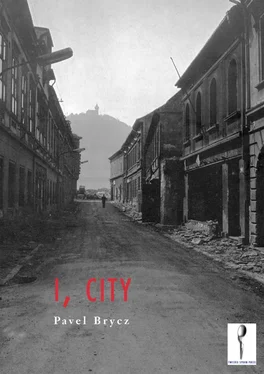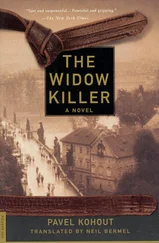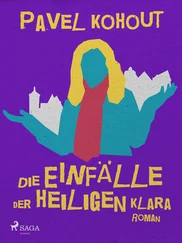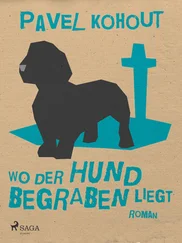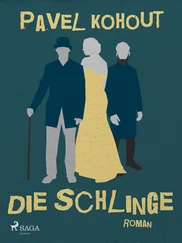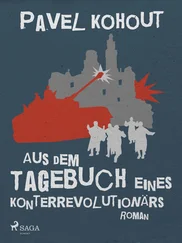Pavel Brycz - I, City
Здесь есть возможность читать онлайн «Pavel Brycz - I, City» весь текст электронной книги совершенно бесплатно (целиком полную версию без сокращений). В некоторых случаях можно слушать аудио, скачать через торрент в формате fb2 и присутствует краткое содержание. Год выпуска: 2006, Издательство: Twisted Spoon Press, Жанр: Современная проза, на английском языке. Описание произведения, (предисловие) а так же отзывы посетителей доступны на портале библиотеки ЛибКат.
- Название:I, City
- Автор:
- Издательство:Twisted Spoon Press
- Жанр:
- Год:2006
- ISBN:нет данных
- Рейтинг книги:5 / 5. Голосов: 1
-
Избранное:Добавить в избранное
- Отзывы:
-
Ваша оценка:
- 100
- 1
- 2
- 3
- 4
- 5
I, City: краткое содержание, описание и аннотация
Предлагаем к чтению аннотацию, описание, краткое содержание или предисловие (зависит от того, что написал сам автор книги «I, City»). Если вы не нашли необходимую информацию о книге — напишите в комментариях, мы постараемся отыскать её.
Dubliners
I, City
I, City — читать онлайн бесплатно полную книгу (весь текст) целиком
Ниже представлен текст книги, разбитый по страницам. Система сохранения места последней прочитанной страницы, позволяет с удобством читать онлайн бесплатно книгу «I, City», без необходимости каждый раз заново искать на чём Вы остановились. Поставьте закладку, и сможете в любой момент перейти на страницу, на которой закончили чтение.
Интервал:
Закладка:
As Most’s people emerge from the pollution, or from the swamp from which the town was founded, we find not individuals, despite their estrangements, despite their loneliness, but representatives. Theirs are historical lives that mistrust history, or that live it at least with typical Schweikian irony. Tellingly, many here are named Novák (which, according to the phone book, is Most’s commonest surname). This is like a book about America in which almost everyone is named Smith. This abstraction, Brycz’s alchemical making of archetype out of stereotype, isn’t accomplished in a spirit of abuse. Brycz obviously loves his “Mosters,” and has more than empathy, or sympathy — he is one of them . As the author, the entity most easily identified with an “I,” he is their city (Most, which, as Brycz tells us, is also Prague, Paris and ancient Babylon), as are all his “Mosters,” all collectively becoming the speaker and subject, experienced and experiencing only in their respective manifestations, their private existences: in what Brycz calls “appearances,” which are brief revelations, or recognitions, Joycean epiphanies straight out of a Bohemian Dubliners . Of course, each “appearance” is modified by an adjectival subtitle. In the most ironic backwater of a cynical East, experience, like emotion, must always be qualified. In “An Appearance, Human,” for example, Brycz writes, “I am a city, I am full of people. Nothing human is strange to me. I love people. And not because they are great. But because they are small, I love them.” A statement naïve on the surface, but knowing underneath. Strangely for a plot of despoiled earth, nothing human is strange to it. It is talking of, and to, and maybe by, the very people who have destroyed it, who have destroyed themselves, whether they’re the oldest Sudeten holdovers from before the war, or the most recent opportunists who’ve just come to the city to mine the last riches before the earth can give no more.
In the course of this translation, Markéta had a momentary vision of the mouth of an enormous earthmover, with the people of Most as its teeth. As it appeared to her, the machine mined the ground, despoiling the city while dulling its sharpness, its teeth — its people. The moral of this story, and of all the stories in this folk-tale-like, fairy-tale book, is that life on this planet can become a symbiotic destruction; no “I” can escape, least of all the planet itself. Recently, plans have emerged for a true “rehabilitation,” one imbued with the best of the current pan-European eco-consciousness. As Most, in its conversion from geology to metropolis, has been manipulated by man ever since its inception, the prevailing idea is to relent now to nature. Unemployment is too high, the standard of living too low. Old people die, young people flee. Most distressingly, the coal will soon all be gone. One proposal gaining support is to flood the basin beside the city, creating an enormous lake, and so returning the city to its beginnings, a primeval swamp under the mountain and its rebuilt castle — now a tourist attraction, boasting an excellent scenic overlook and a serviceable restaurant.
Prague, New York
June 2006
Notes
Miners’ strikes of Most : Primarily wage strikes begun in response to economic crisis and widespread unemployment; 1932’s was then the greatest strike in the history of labor in Central Europe.
Youth League shirts : blue-colored shirts that were the uniform of adolescents (high-school age) too old to be Pioneers, too young to be allowed membership in the Communist Party.
Cadre profiles : a communist-era system of personnel profiling on the basis of an individual’s class background.
Old Town : the original city of Most, almost completely destroyed to enable the furtherance of mining activity.
Hněvín is a Mountain Magnetic : Hněvín is situated near the Ore Mountains, hence this magnetic metaphor.
Hradecers, Budějovicers, Brnoers or Břeclavers : people from the Czech cities of Hradec Králové, České Budějovice, Brno, and Břeclav.
Laura and Her Tigers : a popular pop-rock band founded in Most in 1985. Brycz has written texts for its successor, Zdarr.
Karel Poláček : (1892–1944), Czech novelist and journalist whose most popular book, We Made Five , presents life in a provincial Bohemian town through the eyes of a child.
August 1968 : Czechoslovakia was invaded by the armies of the Warsaw Pact on August 21, 1968, which effectively crushed the fabled “Prague Spring.”
Blaník had been exchanged for Bílá hora : Blaník is a mountain southeast of Prague. Legend has it that an army of Czech knights sleeps within only to awake to save the nation in a time of impending doom. Bílá hora (White Mountain) is now on the periphery of Prague. In 1620, it was the scene of a decisive battle in the Thirty Years’ War with Holy Roman Emperor Ferdinand II routing the Czech Estates, thus ushering in centuries of Habsburg domination in Bohemia.
Josef Sudek : (1896–1976), Czech photographer famous for his black-and-white landscapes; he lost his right arm in WWI.
Gadjo : a derogatory term (akin to "gringo") for someone not Roma.
his native Haná : Haná is a fertile plain around Olomouc in central Moravia that was home to the Hanáks, a Slavic tribe who had their own dialect and traditions and were noted for their beautiful folk songs. Brycz uses the common female name Hanka (diminutive: Hanička) here as a metaphor for the region and its people.
Where is My Home : “Kde domov můj?” the Czech national anthem.
like those from Letohrádek : Letohrádek Hvězda in Prague was built by Archduke Ferdinand of Tyrol in the mid-16th century as a star-shaped summer/hunting seat. Legend claims that during the Battle of White Mountain the brave Moravians defended its walls to the last man. Many historians claim that the Moravians were actually fleeing back to Prague and became trapped at the walls and were left with no other option but to fight.
up to Paradise : Český ráj (Czech Paradise), a protected nature preserve east of Most.
Ginger : the city of Pardubice is famous for their gingerbread cakes; “gingerbread” is also slang for pervitin, the notorious Czech-made methamphetamine, first introduced by the Nazis for their soldiers at the front.
Svinčice : a village ten kilometers from Most known for its horse breeding and stables.
Sinful people are not only to be found in the city of Prague : a reference to the TV crime serial Hříšní lidé města pražského [Sinners of Prague] in which a band of detectives valiantly fights the city’s underworld. The show debuted in 1968 and ran for a number of years.
Buzuluk : a town in the Orenburg province of Russia and the site of a three-day-long battle in June 1918 between units of the Czechoslovak Legion and the Bolsheviks. During WWII, the 1st Czechoslovak Independent Field Brigade was formed there. Commanded by future president Ludvík Svoboda, it fought alongside the Red Army.
Dalibor : a 15th-century legend best known through its 1868 retelling as a story of revenge in Bedřich Smetana’s opera. Dalibor is said to have been a knight who led a rebellion of Czech serfs against a fellow knight, Adam of Drahonice. Prior to his execution as punishment for this betrayal of his class, Dalibor was imprisoned in a tower at Prague Castle, now known as Dalibor Tower.
Winnetou: Last of the Renegades : one of a series of German-language Westerns shot in the 1960s in Yugoslavia and based on the writings of Karl May (1842–1912). The films, immensely popular in Eastern Europe in the 1960s and 1970s, had the Indian Winnetou (Pierre Brice) and Old Shatterhand (Lex Barker), his sympathetic white friend of Germanic descent, join forces to fight against white settlement, which in these movies often represents capitalism and its threat to the nativist “Red Man.”
Читать дальшеИнтервал:
Закладка:
Похожие книги на «I, City»
Представляем Вашему вниманию похожие книги на «I, City» списком для выбора. Мы отобрали схожую по названию и смыслу литературу в надежде предоставить читателям больше вариантов отыскать новые, интересные, ещё непрочитанные произведения.
Обсуждение, отзывы о книге «I, City» и просто собственные мнения читателей. Оставьте ваши комментарии, напишите, что Вы думаете о произведении, его смысле или главных героях. Укажите что конкретно понравилось, а что нет, и почему Вы так считаете.
